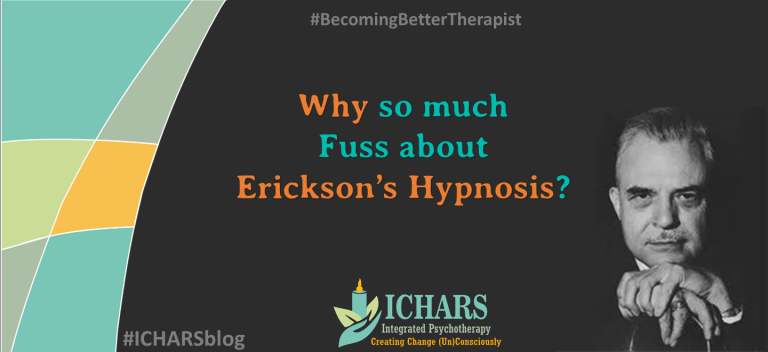Are you intrigued by the subtle art of influencing the subconscious?
Have you ever been captivated by a speaker who effortlessly sways your thoughts with their words?
If you’re looking to master the power of persuasion or dive into the world of therapeutic hypnosis, Ericksonian Hypnosis offers an enigmatic yet powerful approach to creating lasting change. Named after the pioneering work of Milton Erickson, this technique encompasses a range of methods that are both subtle and profoundly impactful.
Let’s uncover what Erickson’s techniques entail and how they manifest in comprehensive online training courses designed for psychologists and life coaches.
What is Ericksonian Hypnosis?
Milton Erickson’s story is a remarkable tale of perseverance against the odds. Born dyslexic and later temporarily paralyzed by polio, Erickson’s early challenges led him to a profound understanding of non-verbal communication and the human psyche.
His innovative approach, now known as Ericksonian or Conversational Hypnosis, emerged from his unique ability to harness the unconscious mind’s power through creativity and intuition.
Unlike traditional hypnotherapy, which often involves direct suggestions, Erickson preferred an indirect, conversational style—the essence of Conversational Hypnosis. This method employs metaphors, storytelling, and subtle suggestions to engage the unconscious mind, making it more receptive to change.
Techniques in Ericksonian Hypnosis

Ericksonian or Conversational Hypnosis uses a variety of techniques, each designed to subtly influence the unconscious mind:
- Utilization: Using the client’s own words, beliefs, and behaviors to facilitate change. For example, if a client mentions a hobby they enjoy, the therapist might weave this into a metaphor for overcoming challenges.
- Metaphor and Storytelling: Crafting stories and metaphors that indirectly address the client’s issues and suggest solutions. A story about a tree weathering a storm could symbolize a client’s resilience.
- Indirect Suggestions: Offering suggestions embedded within conversation, allowing the client’s unconscious mind to accept them without resistance. Phrases like “some people find that taking a deep breath can help them relax” are examples.
- Confusion Technique: Creating a state of confusion to distract the conscious mind, making the unconscious more receptive to suggestions. This might involve presenting information in a non-linear way.
- Pacing and Leading: Matching the client’s verbal and non-verbal behavior (pacing) and then gradually leading them towards desired thoughts or actions. For instance, mirroring a client’s speech patterns before introducing new ideas.
Process Outline of Ericksonian Hypnosis
- Building Rapport: Establish a connection with the client through empathetic communication and mirroring.
- Inducing Trance: Use techniques like storytelling or indirect suggestions to guide the client into a relaxed, focused state.
- Utilizing Trance: Apply indirect suggestions, metaphors, and utilization techniques to address the client’s issues.
- Deepening Trance: Ensure the client remains in a receptive state through deepening techniques like repetitive phrases or progressive relaxation.
- Directing Change: Guide the client towards desired outcomes by embedding solutions within metaphors and stories.
- Eliciting Response: Observe and respond to the client’s reactions, ensuring the suggestions are integrated.
- Bringing Out of Trance: Gradually return the client to a fully conscious state, reinforcing positive changes.
Why Ericksonian Hypnosis?
Ericksonian or Conversational Hypnosis is based on principles of building rapport, distracting the conscious mind, and using indirect suggestions to encourage the unconscious to make changes. Erickson believed that each person holds the keys to their healing and self-improvement; the therapist’s job is to facilitate the discovery.
This approach is versatile and can be applied in various contexts:
- Therapy: Help clients uncover and resolve deep-seated issues.
- Coaching: Motivate and inspire clients to achieve their goals.
- Everyday Conversations: Influence and persuade in personal and professional settings.
Applications of Ericksonian Hypnosis
Erickson’s methods have broad applications, from therapy and coaching to everyday conversations. For instance, a therapist might use a metaphor to help a client view their problem from a new perspective, unlocking insights that lead to resolution.
In coaching, a subtle suggestion might motivate a client to pursue their goals with renewed vigor. Even in everyday interactions, the principles of Ericksonian Hypnosis can help overcome resistance and facilitate constructive dialogue.
Who Can Learn Hypnosis?
Whether you’re a student aiming to establish a practice, a seasoned therapist seeking to add a valuable skill to your set, or just beginning your journey, Ericksonian or Conversational Hypnosis is approachable for all. Its applications are infinite, from therapy to business, personal relationships, and beyond.
Choosing the Best Hypnosis Training
The best hypnosis courses offer more than just theory; they provide a comprehensive understanding of how hypnosis intersects with other fields. Courses integrating Cognitive Hypnotic Psychotherapy™ stand out, combining hypnosis with Mindfulness, NLP, Coaching, and more, offering a holistic training experience that is among the premier hypnosis courses globally.
What to Expect from a Live Hypnosis Training Course
Live online hypnosis training provides all the elements of learning you need: conceptual knowledge, hands-on training, and even post-training support. Here’s what you can expect:
- Pre-Course Modules: Access online modules that provide foundational knowledge, allowing you to come prepared with questions and insights.
- Live Sessions: Engage in live, interactive sessions where you practice hypnosis techniques with other participants. These sessions are designed to be as effective as offline programs, with the added convenience of online accessibility.
- Community and Support: Interact with a community of like-minded learners and receive ongoing support from trainers.
Here is a more in-depth exploration of what you can expect during a live hypnotherapy training.
Conclusion
Live online hypnosis training courses are the gateway to mastering the elusive skill of Ericksonian Hypnosis or Conversational Hypnosis. As you progress from inducing trance states to weaving hypnosis into dialogues, you steadily build a robust repertoire of skills.
If you’re ready to embark on this transformative journey, consider comprehensive training programs like the integrated Cognitive Hypnotic Psychotherapy™ program. Embrace the opportunity to learn in an inviting online environment where your development is cumulative, and each new skill paves the way for the next.
Are you ready to master Ericksonian Hypnosis? Enroll in our conversational hypnosis course today and unlock your potential as a hypnotherapist or a coach.

